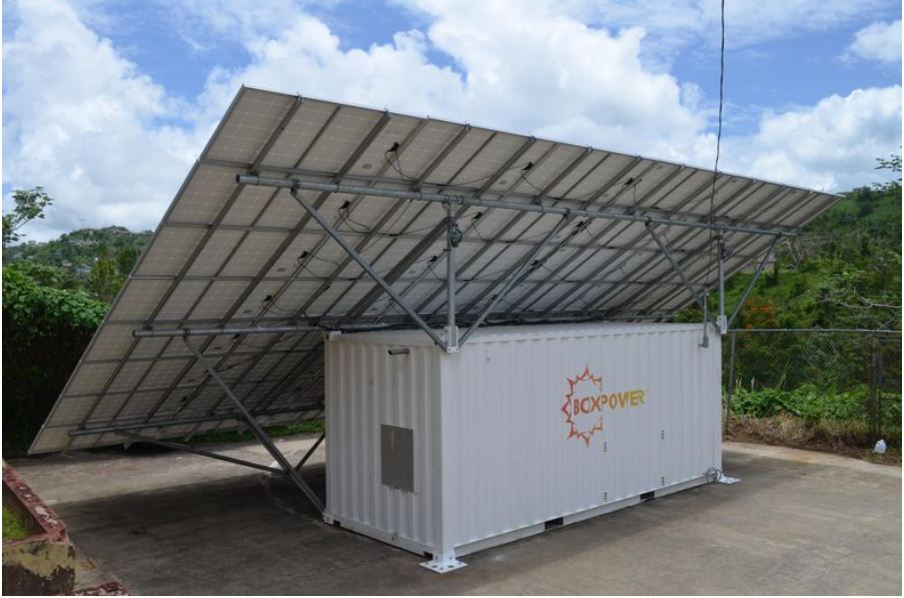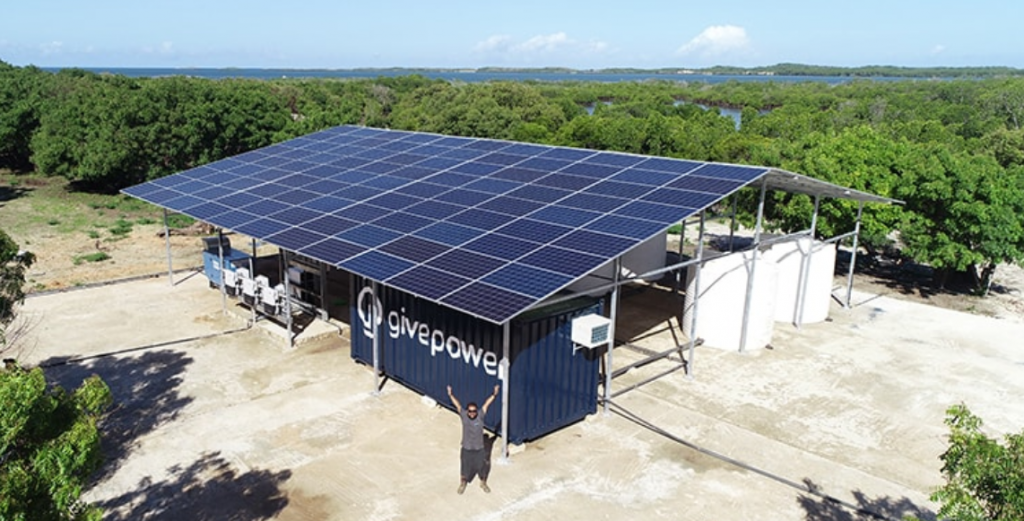Through my research, the last paragraph of this research blog sums it up. By providing the clean water that the women and girls were sent to gather instead of going to school, we can free up that critically demanded need and make time for schooling. Now that we have power and battery storage, containers can also be used for small class rooms facilities during all kinds of weather. I am so confident today that God has put me on this earth to help bring all of the following components together to do His Will:
Solar + Water + Battery Storage + Agriculture + Food + Education + Utilize excess containers by re-purposing them + Help the environment + Emergency Response + Recovery + empower critical services + create community + give hope to those in need + facilitate funding through donations and religious/spiritual organizations.
Micro grids are autonomous grids that operate either in parallel to, or “islanded” from, existing utility power grids. Micro grids use distributed renewable energy that act like small power plants near the buildings, villages, or islands they supply – not hundreds of miles away like large, centralized power plants. This means that these grids experience less “line loss”, or loss of electrical power over distance. Micro grids also remove the need to construct vast amounts of infrastructure just to deliver power. Instead, a micro grid ranging from 1.0 kW to 50 MW in size can be deployed or installed almost anywhere. (https://suninone.com/product-views/solar-powered-micro-grid-systems/)

Wise Power Systems has installed one of the world’s largest 100% solar micro grids on Annobon Island, Equatorial Guinea. The systems is made up of 20,000 solar panels capable of producing up to 5 Megawatts of power, and the system has up to 10 Megawatts of power storage. The island, located 100 miles off the west coast of Africa, previously only had diesel generators that would only produce power for a few hours each day. Now, thanks to Wise Power Systems, the people of Annobon Island have access to electricity 24 hours a day. http://wisepowersystems.com/products/off-grid-systems/

WHAT IS A MICRO GRID?

BoxPower Secures NANA Regional Corporation Contract
Grass Valley, California: BoxPower is excited to announce a contract with the NANA Regional Corporation, LLC, to provide 50kW of power to the community of Buckland, Alaska. BoxPower systems will integrate with the existing microgrid and provide offset to existing diesel generation. BoxPower was chosen as part of a competitive bidding process due to its lower cost foundation and logistics inherent with the container design. BoxPower looks forward to the commissioning of its systems in September and the potential for future similar projects in Alaska.
Sonny Adams, Director of Alternative Energy at NANA Regional Corporation, says that “one of NANA”s goals is to promote healthy communities, and affordable, available energy is a big part of that. Additionally, many of the communities in the NANA region rely primarily on diesel fuel and generators. This solution will provide dependable power that is also clean, important to protecting the subsistence foods we rely on.”
About BoxPower, Inc.: BoxPower manufactures turnkey solar microgrids in 20 ft shipping containers that serve as a reliable and cost effective alternative to diesel generators. Founded in 2016 at Princeton University by Angelo Campus, BoxPower utilizes proprietary technology to provide a 100% reliable and affordable source of renewable energy. Drawing on experiences working in remote locations in Polynesia and US Native American reservations, Angelo saw that the falling prices of solar energy and battery technology could be leveraged to bring clean, affordable energy to off-grid sites. By pre-assembling and mass-producing their systems in shipping containers, BoxPower is able to bring affordable, durable, and scalable energy systems to underserved communities around the world. With customers ranging from Puerto Rico to Alaska, everyone deserves clean power, reliable power, BoxPower.

When devastating weather events like Hurricane Maria leave regions without power, a modular microgrid kit can bring important services online to help communities function better during lengthy rebuilding efforts.
According to a recent article in Microgrid Knowledge, an abandoned school being used as a community center in rural Mariana, Puerto Rico, is being powered with a hybrid microgrid kit manufactured and shipped by California-based BoxPower to Proyecto de Apoyo Mutuo (Mutual Aid Project).
Ariving in a shipping container, the 18,000 lb. kit has solar panels, battery storage and a backup diesel generator — no electrician needed for assembly.
Our system is standardized, all the electrical work is done, there’s no need for an electrician. It’s sort of like an IKEA set,” Angelo Campus, CEO of BoxPower, told Microgrid Knowledge.
Campus also told Yale Climate Connections that the solar array can be set up in five hours.
Mariana’s local firefighters and others erected their unit.
The array can also be broken down and stored in the original shipping container during extreme weather, with power coming from the diesel backup instead. Multiple BoxPower kits can also be linked to meet larger energy load demands.
However, the cost of the microgrid kit is high. Diesel generators typically used in aid response range from $10,000 to $20,000 plus $1,000-$2,000 per month for diesel fuel. BoxPower’s modular microgrid cost $80,000 to $120,000, but lease-to-own financing loans are possible.
Microgrid Offers Hurricane Survivors Long-Term Resilience
The modular microgrid is now powering the rural region’s community center, a laundromat and a cafe. Focused on building long-term resilience, Proyecto de Apoyo Mutuo is establishing the center as a place for children to study and people to work on entrepreneurial projects while the general lack of power in the region continues.
After Hurricane Maria, the project began as post-storm recovery — organized community members went house-to-house to check that people had food, water and shelter. The community is concerned about emergency response services in the current hurricane season, so Proyecto de Apoyo Mutuo volunteers are training, developing emergency response plans and mapping locations of rural Mariana’s residents.
For Immediate Release:
For more information:
Isaac Vanderburg, Managing Director, Isaac@launchalaska.com
Morgan Nelson, Online Presence Director, boxpowersocial@gmail.com
BoxPower Inc. Selected for Launch Alaska Business Accelerator
Launch Alaska’s program selects companies tackling some of the world’s biggest energy and climate problems
ANCHORAGE, AK – Launch Alaska has announced the selection of BoxPower to participate in its 2018 business accelerator in Anchorage, AK. BoxPower was one of four energy companies selected to complete the four month intensive program and receive mentorship, business training, business services, and $75,000 in exchange for equity in their companies.
With the highest cost of electricity and some of the highest per-capita energy consumption in the U.S., Alaska is hungry for energy innovation because of the outsized impact that energy costs have on residents’ pocketbooks. Participation in the cohort provides a unique opportunity for a company to test its technology in remote and harsh conditions.
“BoxPower can’t wait to start working with these incredible teams, tackling the challenge of deploying renewable energy systems in one of the toughest environments on the planet.”
“The companies selected for the Launch Alaska program offer promising innovations for the energy sector here in Alaska and globally,” said Isaac Vanderburg, Manager Director, Launch Alaska. “We look forward to working closely with these innovators to begin solving some of the state’s most intractable problems – leveraging emerging technologies like AI and blockchain to address energy cost and deployment challenges. Alaska can and should be a hub for innovative solutions to meet some of the most pressing global challenges.”
Each company will receive $75,000 in funding in addition to intensive mentoring, technical assistance, facilities and networking connections from the Launch Alaska mentors and partners. At the conclusion of the program, participants will be invited to showcase their efforts to both the mentoring teams, potential third-party investors and the local community during the Launch Alaska Accelerator Demo Day on June 28, 2018. Launch Alaska may select the most promising companies for their Deployment Track which includes additional funding and mentoring to demonstrate and commercialize their technology.
About Launch Alaska:
Launch Alaska is powering the founders of our energy future. We’re bringing together entrepreneurs, members of the military, utility operators, researchers and thought leaders to work toward a shared vision of Alaska as a thriving innovation and entrepreneurial hub. From drones to climate change mitigation, and from electrical grids to cyber security, Alaska holds value and experience that a growing entrepreneurial ecosystem is beginning to capture. We seek companies that are innovating solutions to make our communities and organizations more resilient while tackling some of the world’s biggest energy and climate problems. Learn more at Launchalaska.com.

About BoxPower:
BoxPower provides innovative infrastructure solutions to off-grid and underserved markets worldwide.
BoxPower believes that the future of energy should be sustainable, modular, and distributed. This vision has led us to develop the world’s largest containerized hybrid renewable energy system. And we’re just getting started. We design and manufacture custom, modular, off-grid energy systems for any application, with the goal of bringing our technology to the 1.2 billion people worldwide without grid electricity.
We’re looking forward to our new partnership!
BoxPower
Turnkey microgrid-plus storage systems have been having a moment in the wake of the California utilities’ recent public safety power shutoffs.
“After two weeks of outages and utility shutoffs, many businesses have had to shut their doors because of cash flow issues or because they lost their inventory at a critical time of the year,” said Angelo Campus, founder and CEO of BoxPower, a startup that makes pre-engineered microgrid plus storage systems that can be dispatched and stored in shipping containers.
More climate-vulnerable companies no longer see small and medium-sized microgrids as a “nice thing to have,” but something that they need to have, he said.
BoxPower is in the market with two turnkey microgrid solutions plus storage products, one that relies solely on solar power and another that uses solar power and natural gas. If you think of the potential applications for this, it will be applicable in areas hit hard by climate change.”Solar and renewable resources are inherently intermittent, and many commercial clients want to know that they will have 100 percent reliability in the event of an outage,” Campus explained. Hybrid solar/generator systems provide an ideal combination of cost savings from the solar and guaranteed reliability from the generator, he added.
In 2020, BoxPower’s C&I focus will be on geographies susceptible to extreme weather brought on by climate change, such as California, the east coast and the Caribbean. BoxPower is also looking for opportunities at schools and gas stations.
“It is less electric car-focused; gas stations fit our customer profile. They are the right size [for BoxPower’s turnkey microgrids],” he said. During outages, some gas stations rely on generators, but many have no backup power at all. “In Nevada County [California], there was only one gas station open during the last round of PSPS events, and there was a four- to six-hour line of people waiting to fill gas tanks for their cars and home generators,” he added.
As a concept, BoxPower’s shipping container-based turnkey solar microgrid solution was a reaction to the 2010 earthquake in Haiti. Efforts to mobilize generators for critical services after that disaster failed because Haiti’s power system went down and the country experienced fuel shortages, resulting in many deaths from preventable disease due to the inability to refrigerate medicines and vaccines.

EVs will become a significant driver of the microgrid industry two to four years out, and they will need a place to charge.”Most, if not all, critical power facilities — like hospitals, data centers and manufacturers — have already invested in emergency power systems. This new capability gives these facilities the ability to perform microgrid system functions, including demand charge management, time of use optimization, demand response and frequency regulation,” Vernacchia said.
Gridscape Solutions is focused on solar-powered-plus-storage microgrids and electric vehicle (EV) charging systems.
“Battery prices and EV prices are both going down. [In the coming years] it will be important for automakers and fleet owners to leverage EV as a source of power during an emergency,” Gore said.
The ability to discharge energy, as well as charge, would enable EV fleet owners to use — and in some instances monetize — their power.
In the coming year, Gridscape plans to continue focusing on its microgrid-based EV charging stations and related services. It is also exploring ways to service hotels as they look to develop EV charging solutions for guests. “[Hotels] can put an EV charging station in front, so EVs can charge at night, and they can make money,” Gore said.
Saft
It should come as no surprise that the French oil and gas giant Total and its battery energy storage subsidiary, Saft, are expanding in the microgrid space.
Last spring, Saft acquired Go Electric, an Indiana-based startup specializing in turnkey renewable microgrid solutions. Whereas Go Electric has focused on developing microgrid solutions for commercial and industrial customers, communities and military bases, Saft’s business has centered on storage for solar-diesel or wind-diesel hybrid microgrids for remote communities and mining companies.
To date, most of Saft’s microgrid projects have been for customers eager to save on fuel and lower their emissions, said Jim McDowall, senior technical advisor at Saft.
Saft and Go Electric are still functioning as separate groups.
Most large oil and gas companies have been investing in and developing renewable projects that involve storage, but Total is the only major energy giant that owns a battery manufacturer.


“You not only want your locations to keep running, but you want the people who work there to be safe and to have a place to go. It’s all about society. The concept of a community microgrid or microgrid cluster now comes into play for a C&I [customer] that is trying to bring resiliency to its employees,” Wiedetz said.
FEATURES
Solar Photovoltaics – renewable energy powers the grid, keeping minimal operation costs
Energy Storage – battery storage is used to enhance stability and efficiency of micro grids
Generators – highly efficient diesel generators provide backup power only when necessary
Control System – centralized control system that manages the load flow within the power network
Containerized System – weatherproof containers keep system highly scalable and deployment costs low
BENEFITS
– Reduces reliance on fossil fuels
– Fast installation of electricity supply
– Reinforce or extend the current infrastructure
– Grid stabilizing technology
– Turnkey product ensures simplicity


The GivePower non-profit founded by Tesla subsidiary SolarCity is supplying solar-powered desalination systems to some of the world’s neediest communities, backed by Tesla’s Powerwall battery technology.
FEBRUARY 6, 2020 JEAN HAGGERTY
GivePower is launching containerized, solar-powered water desalination and purification plants in Mombasa, Kenya and La Gonave, Haiti this quarter. Like GivePower’s debut solar-powered microgrid desalination plant, which went live in Kiunga, Kenya in 2018, these new projects will operate with Tesla’s powerwall battery storage technology.
At launch, both of the nonprofit’s new solar water farm projects will produce a maximum of 75,000 liters of water a day by coupling a 50-kW solar system with 120 kW-hrs of Tesla batteries; together this solar plus battery system will power two low-wattage, reverse osmosis desalination pumps that run simultaneously to ensure continuous operation.
When developing solar-powered desalination projects, pinning down the point at which the technology and the operating model make economic sense is key because the one of the biggest challenges with solar desalination is the amount of energy that it takes to desalinate sea water. Often, this outsized energy need means that a plant requires a larger solar array, which increases the cost of the project.
“We need to see that [these philanthropic] projects are economically viable – that these projects can continue to operate without ongoing funding from donors to keep the systems operational,” said Kyle Stephan, GivePower’s vice president of operations. In addition to building solar water farms, GivePower trains local technicians to operate the plants.
GivePower’s solar water farm systems cost just over $500,000, and they have a 20-year expected lifespan.
Commercial applications for GivePower’s solar water farm technology are not in the pipeline currently, according to Hayes Barnard, CEO of GivePower.
When it comes to developing commercial off-grid, solar-powered desalination systems for water-stressed communities, industry officials see solar microgrid players as particularly well placed to offer solutions.
Drought, saltwater intrusion and climate change are intensifying the need for solutions that use renewable energy to address water scarcity. Simultaneously, falling PV prices and energy storage innovations are making solar-powered desalination solutions more appealing.
So far, all of GivePower’s solar water farms are coastal well-based desalination plants. This is because 98% of the world’s water is in the ocean, and 73% of the world’s population live in coastal areas, where well water is susceptible to becoming brackish, Barnard noted. Additionally, off-coast solar desalination plants’ intake processes are expensive, and coastal well-based solar water farms do not stress underground aquifers.
For its project on La Gonave, which is off the coast of Port-au-Prince, GivePower is applying international building code seismic requirements for its solar water farm’s concrete foundation, and it is building a solar canopy that is capable of withstanding a category-four hurricane.
Initially, the nonprofit focused on providing solar-powered lighting to schools without electricity in the hope that this would open up educational opportunities for girls in developing countries. But quickly it became clear that helping communities achieve water security was key to addressing this issue because often girls were often missing school because their days were spent fetching water, according to Barnard, a GivePower co-founder. GivePower became an independent organization in 2016.
Last week GivePower’s solar-powered desalination technology received the UAE’s Global Water Impact Award for innovative small projects.

